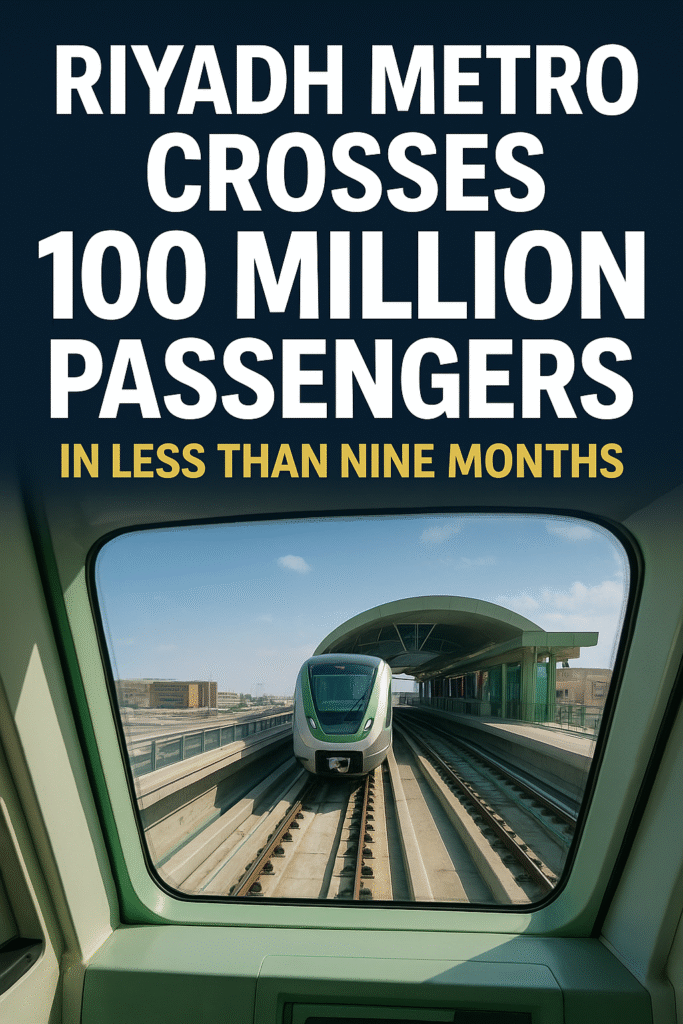Riyadh, Saudi Arabia – The Riyadh Metro has achieved a remarkable milestone by transporting further than 100 million passengers in under nine months since its launch in December 2024. This achievement not only highlights the capital’s commitment to ultramodern civic mobility but also positions Riyadh Metro as one of the fastest-growing public transport systems in the world. This major accomplishment signals a major metamorphosis in how residents and callers move across the megacity, while also showcasing Saudi Arabia’s growing success in enforcing large-scale structure systems in line with Vision 2030. A Game-Changing Transportation System: The Riyadh Metro is more than just a transport network — it represents the future of smart, effective, and sustainable civic mobility in the Kingdom. Managed by the Royal Commission for Riyadh City, the metro has maintained a punctuality rate of 99.7 percent, according to the Saudi Press Agency. This emotional trustworthiness has encouraged commuters to switch from private buses to public transport, easing business traffic in the capital. Since its induction, the metro has swiftly gained popularity among residents, deportees, and callers. With millions counting on it daily, the metro has become an integral part of Riyadh’s identity as an ultramodern, forward-looking megacity. Passenger Growth and Popular Routes Statistics reveal the extent of the system’s popularity. The Blue Line recorded the loftiest ridership, with more than 46.5 million passengers, making it the busiest route on the network. The Red Line followed with 17 million trippers, while the Orange Line attracted 12 million passengers. This swell in ridership demonstrates the public’s trust in the service and highlights the demand for dependable transport services in a rapidly growing megacity like Riyadh. Key Stations Driving High Footfall. Some stations have surfaced as central capitals for diurnal commuters and excursionists, likewise. ASR Al-Hokm, KAFKA, STC, and the National Museum stations accounted for nearly 29 percent of total passenger figures. Their fashionability is linked to their proximity to artistic milestones, government centers, and business sections, making them vital points for both work and rest. These stations aren’t just transport stops but also symbols of how the Riyadh Metro integrates seamlessly with the megacity’s social and economic life. The 100 Millionth Passenger. The metro’s success was further stressed when Masaad Al-Obaid became the 100 millionth passenger. Originally uninformed of the corner during his routine trip, Al-Oaid was informed by metro staff and later recognized with a special trip card granting him free lifts. Participating in his excitement, Al-Obeyed said,” The Riyadh Metro has made my life so much easier. It saves time, reduces stress, and removes the constant headache of business logjams. My diurnal commute is now smooth, effective, and stress-free. ” His evidence reflects the gains of numerous commuters who now calculate the metro as a reliable and comfortable means of travel. Voices of the Public The achievement of crossing 100 million passengers reverberated extensively among Riyadh’s residents. Tausief Ahmed, a regular commuter, expressed his studies to Arab News, “It is truly emotional that Riyadh Metro has formally reached this corner in less than nine months. Since its opening in December, it has fully converted how people swap in the capital. It is brisk, smarter, and far more accessible than traditional trip options. ” These public sentiments punctuate how snappily the metro has become embedded in the everyday lives of Riyadh’s citizens. The Longest Driverless Metro Network in the World. One of the most striking aspects of the Riyadh Metro is its status as the world’s largest driverless metro system. Covering an expansive 176 kilometers, the completely automated system is designed with slice-edge technology that ensures smooth operation, safety, and effectiveness. This massive structure design not only enhances trip convenience but also reduces the megacity’s dependence on private vehicles, aligning with broader sustainability pretensions. Integration with Vision 2030 The Riyadh Metro is a flagship action within Saudi Arabia’s Vision 2030, the public metamorphosis program aimed at diversifying the economy and contemporizing public services. Perfecting civic mobility is a central ideal of this vision, and the metro system plays a critical part in achieving that. By expanding access to public transportation, reducing business traffic, and minimizing carbon emissions, the metro strengthens Riyadh’s character as a global megacity ready for unborn challenges. Looking ahead, Saudi Arabia plans to expand its road network by further than 50 percent, connecting major metropolises across the Kingdom. These expansions won’t only enhance domestic trips but also boost trade and profitable investment, buttressing the Kingdom’s role as an indigenous mecca. A New Era of Smart Mobility: The success of the Riyadh Metro underscores the growing demand for smart, sustainable, and technologically advanced transportation. With more people embracing the system every day, the metro is reconsidering mobility norms in the Middle East. The network is equipped with state-of-the-art installations, including ultramodern trains, comfortable seating, advanced marking systems, and accessibility features for people of determination. These inventions make the metro not only functional but also inclusive. Benefits for the Capital: The benefits of the Riyadh Metro extend far beyond convenience. They include Time Savings: Faster progressions compared to traditional road trips. Reduced Traffic: Significant relief from heavy business on Riyadh’s busy roads. Environmental Impact: Lower carbon emissions due to reduced reliance on buses. Profitable Growth improved connectivity fosters commerce, tourism, and business openings. Social Connectivity Enhanced access to artistic, marketable, and educational capitals. Conclusion: A corner for the unborn. The Riyadh Metro’s achievement of carrying 100 million passengers in less than nine months isn’t just a statistical record, but it is a testament to Saudi Arabia’s capability to deliver a transformative structure that improves quality of life. As Riyadh continues to grow into a global megacity, the metro will remain at the heart of its development, bridging communities, easing travel, and setting the standard for ultramodern public transportation in the region. With ambitious expansion plans underway and a clear alignment with Vision 2030, the Riyadh Metro stands as a symbol of invention, progress, and the Kingdom’s vision for a smarter, more connected future.




0 Comments